-
Car Reviews
- All reviews
- Midsize SUVs
- Small cars
- Utes
- Small SUVs
- Large SUVs
- Large cars
- Sports SUVs
- Sports cars
- Vans
Latest reviews
- Car News
-
Car Comparisons
Latest comparisons
- Chasing Deals
The Toyota RAV4 Hybrid achieves stellar fuel economy for a roomy midsize SUV, but it doesn’t make you sacrifice power and decent performance. But is the mid-specification RAV4 GXL the best model to buy?
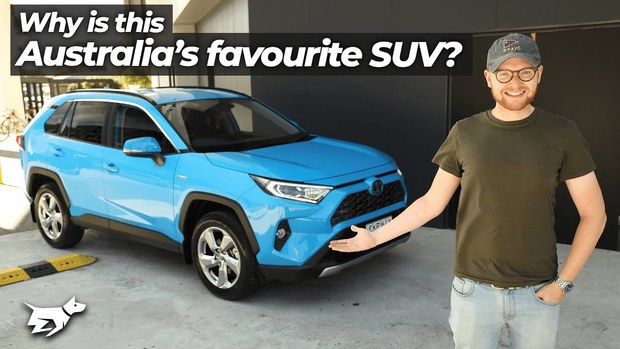
The Toyota RAV4 Hybrid has taken the Australian new car market by storm because it has totally redrawn expectations of how frugal an SUV can be – without diluting important factors like performance and everyday practicality.
We’ve spent considerable time with a RAV4 Cruiser Hybrid long-termer, and our conclusions were that the luxurious Cruiser grade, which costs circa-$50,000 on the road, was worth the considerable spend because it included just about every feature you’d want.
But with availability of the Cruiser Hybrid as scarce as hen’s teeth, what is the next model down the RAV4 rungs like to drive and live with? In today’s RAV4 review, we take a look at the GXL Hybrid eFour, which costs $42,915, sitting above the front-drive GXL Hybrid ($39,915) in the lineup.
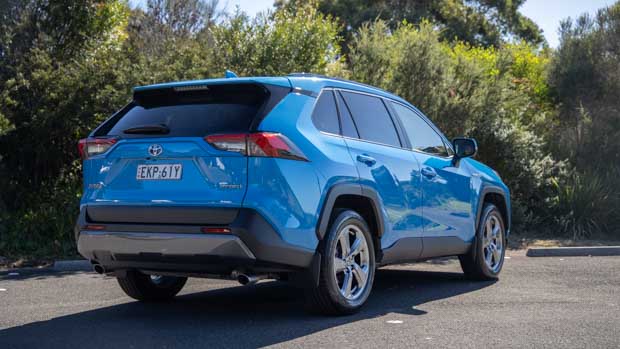
The Toyota RAV4 Hybrid makes so much sense because you don’t really have to compromise on driving dynamics, despite the excellent fuel consumption.
We’ve already covered at length that the RAV4 Hybrid pretty much lives up to its claims of exceptionally low fuel consumption. In four months of driving a RAV4 Hybrid every day, we reliably managed 6L/100km or even lower.
Plus, the drivetrain Toyota slots into the RAV4 dispels any old notions that a hybrid car has to be a slug on the road. Producing 160kW of power in front-wheel-drive form, and 163kW if you opt for eFour AWD as tested here, the RAV4 Hybrid gets up and goes, returning 0-100km/h times of about eight seconds.
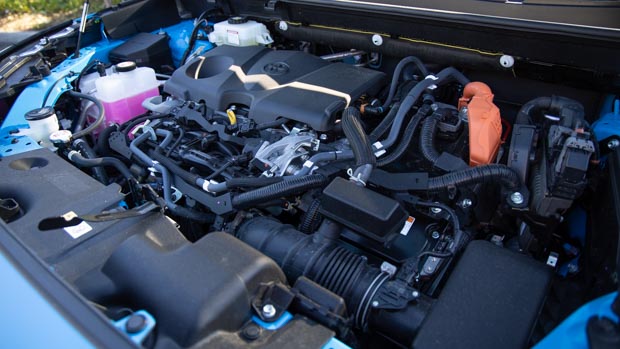
It’s not a hot SUV, per se, but the RAV4 Hybrid is no slouch, with a nippy persona around town and plenty of torque for overtaking on country roads. Certainly, the 2.5-litre petrol-electric hybrid engine is a substantial step up in performance compared to the base model RAV4 engine, which is the 2.0-litre non-hybrid used in the Corolla hatch and sedan.
That said, while the RAV4 Hybrid offers relatively good performance, it doesn’t always sound so great going about it. Around town, it mainly glides around on all-electric power – this is serene. But as you start to demand full shove from the powertrain, the underlying petrol engine gets quite revvy, and thanks to the CVT, it can sound strained.
Similarly, brake feel is middling at best, with the pedal switching noticeably between regenerative braking and the physical brakes of the car. Toyota still has some way to go on improving pedal feel in their hybrids, even as most of the rest of the combination now works seamlessly.
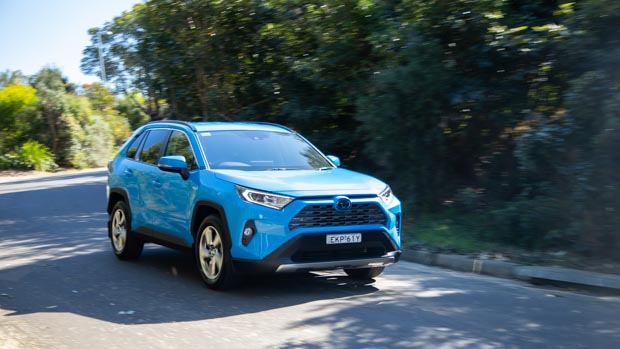
More or less seamless is what you’d say about the transition from electric to petrol power. Ten years ago a hybrid would shudder between the two sources of energy, but no longer – Toyota have done a very good job insulating this complex process from the occupants.
You can sense it if you listen carefully or watch the EV meter – and in fact, we found ourselves subconsciously trying to eke out as much use of full-EV mode as we could, simply by being a little more gentle on the throttle on take off. It’s quite satisfying.
Then there’s the ride and handling, which is comfortable and composed, and even offers a modicum of driver engagement.
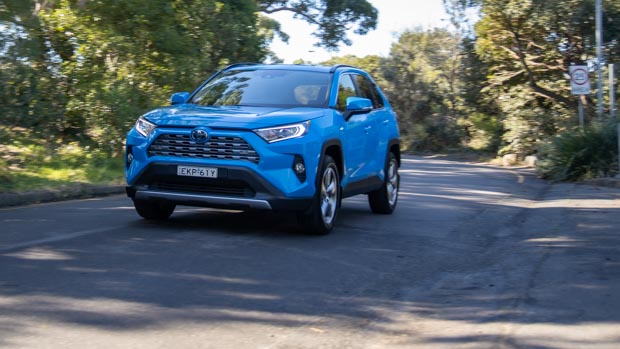
A Volkswagen Tiguan or Mazda CX-5 are considerably sportier to drive, but if you find yourself with a Toyota RAV4 Hybrid on a technical Australian country road, you’ll be surprised just how competent this SUV is.
Compared to the last RAV4, which had precisely zero aspirations of driving fun, the new car is bubbling with ability. It’s still pitched as a softly-sprung crossover, so you do have to be a little patient, but with a natural-feeling steering rack, relatively quick ratio, good composure, electric punch out of corners and even a slightly playful stability control tune, the RAV4 can be fun.
Some drivers coming out of European SUVs will want for a bit more control over speed bumps in town, where the RAV4 can feel less tied down vertically than some rivals, but most of the time, this is just an easy and relaxing car to drive without any serious impediments.
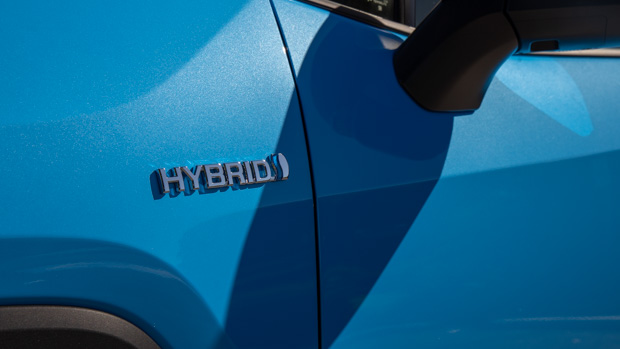
It’s also a quiet car. Refinement is superb and not all that far off a Lexus. The only things disrupting the environment are occasional sounds from the motor, the engine if you give it a huge rev, and every so often, a noise from the rear suspension, which we’ve heard on three separate cars and should be addressed at facelift time.
In terms of safety kit, Toyota is egalitarian with the RAV4 – all the grades get the same kit. There is forward AEB with car, pedestrian and cyclist detection, adaptive cruise control, lane trace assistance, automatic high beam, road sign detection, blind spot monitoring, rear cross-traffic alert, and a reversing camera.
It should be noted no RAV4 has reversing AEB, and the lane tracing is very weak – the same system in a Hyundai Tucson is much stronger and more accurate.
There is a distinct split in the Toyota RAV4 range when it comes to interior plushness. The top-shelf Cruiser and Edge (reviewed here) have leather-lined interiors with higher-quality secondary surfaces, while the lower-end GX and GXL grades make do without leather seating and, oddly, with much more hard plastic in the cabins.
Usually, door and dash quality is fixed across all variants of a given make and model, but in the RAV4, Toyota is noticeably stingier when it comes to the GX and GXL in the cabin.
That’s not an approach we tend to like. For example, in the GX and GXL, you get fully hard plastic door skins on all four doors. But in the Cruiser and Edge, all four doors are trimmed in much softer leatherette. A small thing like that goes a long way for perceived quality.
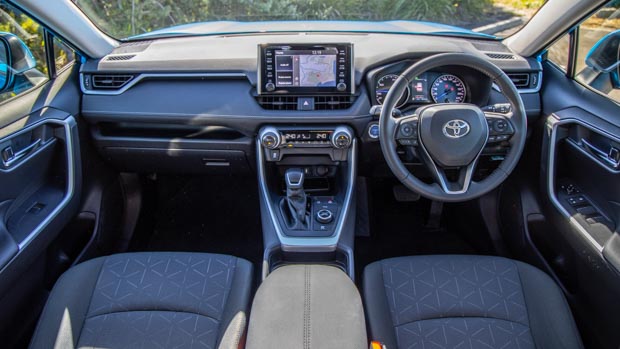
Similarly, the cloth seats used on the GXL is fine, but it does feel more like a fleet special. By contrast, the Cruiser is fitted with heated black or amber-coloured leather, while the (non-hybrid) Edge has black and orange leather that looks great.
Either way, though, there’s no disputing the underlying quality of the build of the RAV4. It’s a solid and durable feeling car, and fit and finish is good. The seating is comfortable, especially up front, and our testing with many hours behind the wheel still left us feeling relatively fresh.
The ergonomics of the RAV4’s interior are especially good, with the leather steering wheel falling in a natural position, with the automatic gear shifter just a short reach away. Similarly, the eight-inch touchscreen is easily within reach.
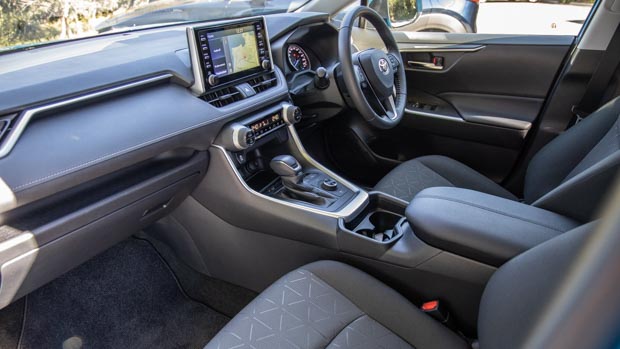
Speaking of the touchscreen, the RAV4’s technology is well laid out and easy to use. It’s no tech leader, like a Volkswagen Tiguan, though – there’s no wireless CarPlay or digital gauges to be found here. You do get wired CarPlay and Android Auto via USB cable, though, and at least the analogue dials are readable…
…particularly in light of the fact the RAV4 Cruiser’s digital instrumentation is afflicted badly by glare, which isn’t ideal. And even in the GXL, the central touchscreen becomes really washed out far too easily in Australian sunlight.
Storage is good no matter which RAV4 grade you buy, with big door bins and space between the seats beneath the driver’s armrest.
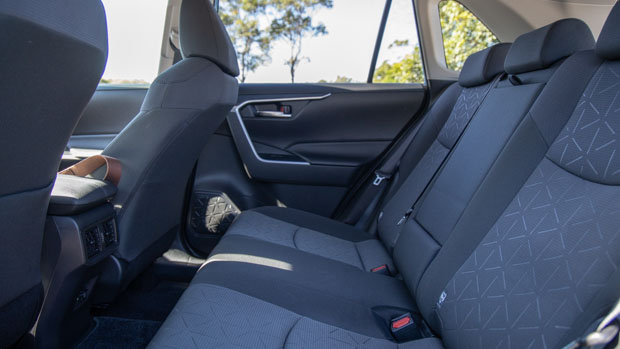
Driving the GXL, we’re reminded why we think the $3,500 step up to the Cruiser makes a lot of sense, if you can get your hands on one. The combination of nicer materials, electric driver’s seat adjustment, front seat heating, the addition of a JBL stereo and a sunroof add up to much more than that dollar figure.
Moving backwards to Row 2 reveals another reason Australian families have taken to the RAV4 in droves. It’s a big car, plain and simple – headroom and legroom are excellent for adults and kids alike.
Rear air vents are standard in the GXL, and there’s also a deployable centre armrest for those longer trips. But as we noted up front, the doors are completely hard.
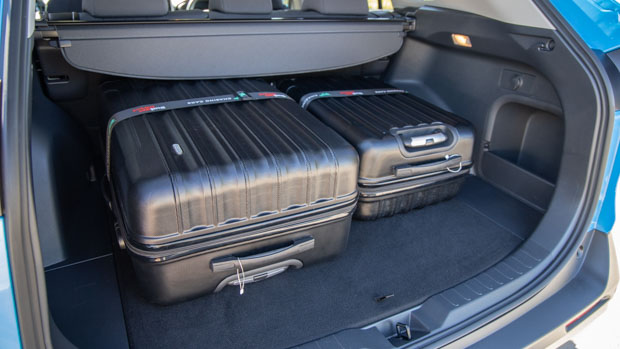
You get a pretty big boot in the RAV4, with the cargo sapce measuring in at 542 litres. Those wanting a power tailgate will have to step up to the Cruiser, though.
Plus, don’t bother looking for hooks or remote cargo releases – it’s really just a big space for stuff. A space saver spare is standard beneath the boot floor: a full-size spare is only available on the base GX.
The Toyota RAV4 currently has the lowest running costs in the midsize SUV class, which makes it very attractive to family and fleet buyers alike.
That mix starts with fuel consumption, which is genuinely low in the real world. Toyota claim combined consumption of 4.8L/100km. We’ve managed to achieve between 5-6L/100km without trying too hard in a range of RAV4 Hybrid eFour grades such as the car on test.
It’s also worth noting that you can fill the RAV4 Hybrid with 91-octane regular fuel or E10.
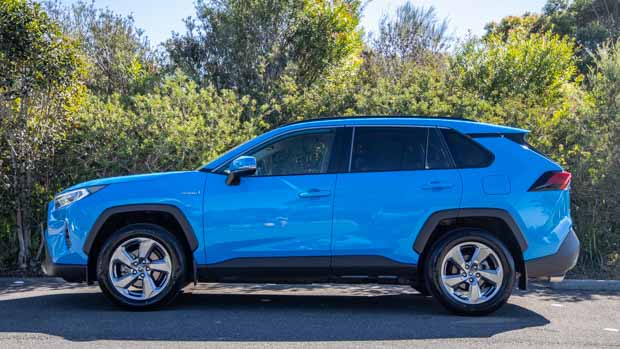
Toyota caps the price of the first four RAV4 scheduled services. Maintenance occurs every year or 15,000km – whichever comes first. Each of those first four services is pegged at $215 at current rates, though the fifth year is uncapped, so we can’t provide a definitive five-year service cost.
Like the brand’s other cars in Australia, the RAV4 benefits from a five year, unlimited kilometre Toyota warranty.
The Toyota RAV4 Hybrid is an excellent midsize SUV. It blends true real-world frugality with usable performance, well-sorted ride and handling, and a large and practical interior.
We welcome the fact that you can get into a RAV4 Hybrid affordably, via the base GX ($37,070) and GXL ($39,915) front-drive trims.
However, we also stand by our advice that if you can stretch to the RAV4 Cruiser Hybrid ($43,415), it makes a world of sense with the extra features and greater comfort that variant brings.
We don’t recommend a range-topping model just because it’s fancy – in this case, the value case simply stacks up better for the Cruiser.
Variant tested GXL (AWD) HYBRID
Key specs (as tested)
About Chasing cars
Chasing Cars reviews are 100% independent.
Because we are powered by Budget Direct Insurance, we don’t receive advertising or sales revenue from car manufacturers.
We’re truly independent – giving you Australia’s best car reviews.
The estimate provided does not take into account your personal circumstances but is intended to give a general indication of the cost of insurance, in order to obtain a complete quote, please visit www.budgetdirect.com.au. Estimate includes 15%^ online discount.
^Conditions Apply
Budget Direct Insurance arranged by Auto & General Services Pty Ltd ACN 003 617 909(AGS) AFSL 241 411, for and on behalf of the insurer, Auto & General Insurance Company Limited(ABN 42 111 586 353, AFSL 285 571).Because we don’t know your financial needs, we can’t advise you if this insurance will suit you. You should consider your needs and the Product Disclosure Statement before making a decision to buy insurance. Terms and conditions apply.
Indicative quote based on assumptions including postcode , 40 year old male with no offences, licence suspensions or claims in the last 5 years, a NCD Rating 1 and no younger drivers listed. White car, driven up to 10,000kms a year, unfinanced, with no modifications, factory options and/or non-standard accessories, private use only and garaged at night.
^Online Discounts Terms & Conditions
1. Discounts apply to the premium paid for a new Budget Direct Gold Comprehensive Car Insurance, Third Party Property Only or Third Party Property, Fire & Theft Insurance policy initiated online on or after 29 March 2017. Discounts do not apply to optional Roadside Assistance.
2. Discounts do not apply to any renewal offer of insurance.
3. Discounts only apply to the insurance portion of the premium. Discounts are applied before government charges, taxes, levies and fees, including instalment processing fees (as applicable). The full extent of discounts may therefore be impacted.
4. We reserve the right to change the offer without notice.